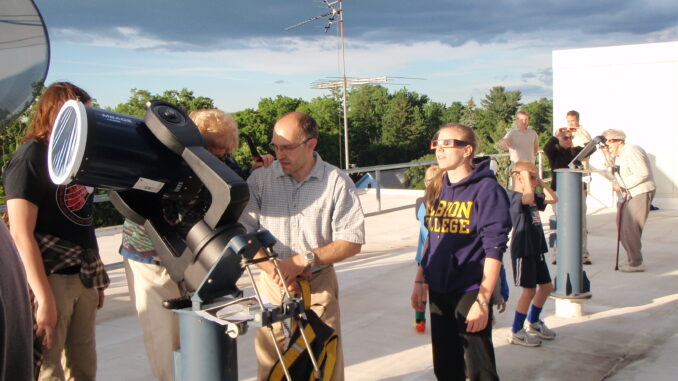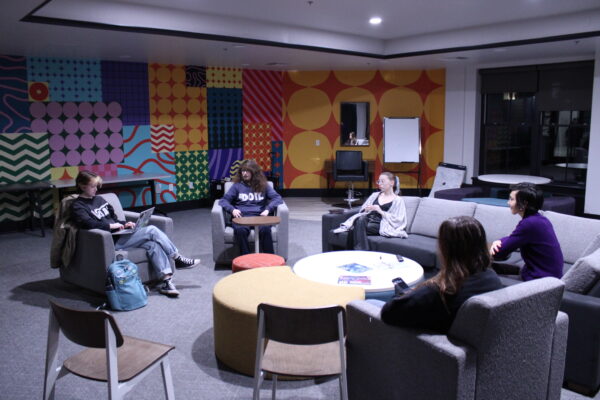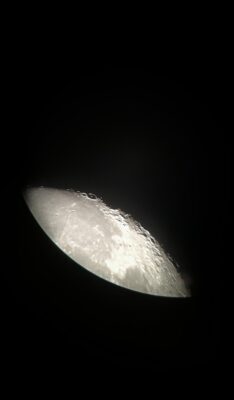
When one thinks of astronomy, it’s easy to imagine equations on a chalkboard, late nights in physics labs or telescopes aimed skyward by science majors. But for Traverse City junior and Astronomy Club President Sela Geraci, the subject is something much more human.
A double humanities major, Geraci said they lead a club that’s “really thought-based and engaging” where “there’s something for everyone.”
“Even if it’s just learning to point out one constellation – that’s fun,” Geraci said.
A Legacy Written in the Stars
Geraci originally encountered the astronomy club during their first year at Albion, where they said it was only just “coming back to life.” What they didn’t know, according to professor of physics and club advisor Nicolle Zellner, was that the club dates back to “the 1800s,” making it one of Albion’s oldest.
Livonia senior and club secretary Kaelyn Ruiter, a chemistry and physics double major, said they joined not only for the science, but for the sense of community.
“Astronomy is kind of what I’m studying, I want to go into higher education for astronomy or astrochemistry,” Ruiter said. “When I heard there was an astronomy club, I knew I had to join. But it’s also just a really relaxed, friendly space where anyone can learn about the sky.”

Geraci said their sophomore year was a crash course in student leadership, where they spent a year building an executive board, setting up the constitution and organizing the club’s first new events.
“There wasn’t a predecessor to teach me how to do any of this,” Geraci said. “I was figuring it all out from scratch.”
With Zellner on sabbatical, the club is temporarily being advised by visiting assistant professor of physics Daniel DeYoung. Though his background isn’t in astronomy, DeYoung said he views the field as “physics’ bridge to the rest of the world.”
“I think the only people who aren’t actually interested in the stars and looking at the night sky are people who haven’t done it,” DeYoung said.
A Space for Everyone
Since taking the helm, Geraci said they’ve worked to make astronomy approachable to everyone, regardless of major.

“We’ve done trivia and documentary nights,” Geraci said. “We make sure the trivia is easy, with questions you can guess, and if not, you learn something.”
That accessibility, Ruiter said, is central to the club’s mission.
“A lot of what we do is really laid back, we just talk about space in general, not the heavy physics side,” Ruiter said. “We’ll do events like observation nights or star walks out at the Nature Center, just pointing out constellations and hanging out. It’s fun, not stressful.”
The astronomy club’s next community-wide event will be a star walk today at 7:30 p.m. at the Whitehouse Nature Center.
DeYoung said those moments of discovery are what make astronomy special. With the club’s telescopes, students can “actually see Saturn’s rings – not in perfect detail, but enough to know they’re there.”
“You can see Jupiter’s moons, the craters of the moon,” DeYoung said. “Things you’ve only ever seen in pictures suddenly become real.”
Over the years, Zellner said the club has helped organize public observation nights for major astronomical events like the 2012 Venus transit, 2017 solar eclipse and the 2024 eclipse.
Reaching for the Next Horizon
Looking ahead, Geraci said their goal is to “create a more stable structure for future members,” with their main hope being to “someday take a field trip.”
“Maybe to the Chicago Observatory and do something bigger off campus. We have the funds for that, and it would be super cool,” Geraci said.
DeYoung said his dream destination would be “anywhere that’s actually dark.”
“There are telescopes in Hawaii and Peru where there’s almost no light pollution at all, that’s when the sky really opens up,” DeYoung said.
The horizon is already expanding for Zellner, who said, “President Webster has invested money into upgrading the telescope in the dome.”
Other upgrades, Zellner added, include vibration mitigation, dome synchronization and the addition of a weather station that will eventually allow remote observation.
“Students won’t even have to be in the building – they’ll be able to operate the telescope from elsewhere,” Zellner said. “It means Albion can become part of a national network of telescopes that share data across the country.”
The best part of the club besides the equipment, Ruiter said, is watching people’s reactions when they look through the telescope for the first time.
“Seeing someone realize they’re actually looking at Saturn’s rings or the craters on the moon, it’s like this shared moment of awe,” Ruiter said.
Whether on Albion’s rooftop or under the clearest skies possible, Geraci said the astronomy club’s purpose is simple: “we just want people to look up, that’s all it takes to start.”

Leave a Reply